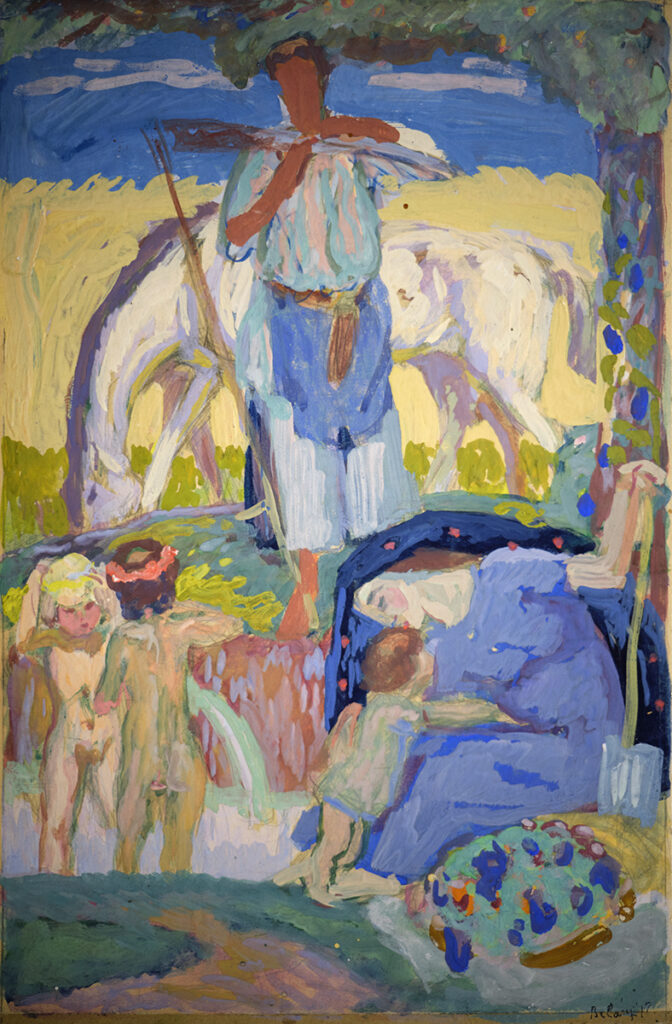Nitra Gallery’s depository includes a collection of various pieces by Viktor Belányi, whose work is gradually being forgotten. The sketch painted in tempera is a family picture. It depicts a standing man sharpening his scythe with a white grazing horse and yellow fields behind him. In the foreground, in one corner of the image, there are two children wearing wreaths woven from flowers. There is a sitting woman with a child in another corner, compositionally resembling Madonna, one could say that Belányi’s depiction portrays a woman – Madonna with a spade. The technique used to capture the harvest time story has a slightly post-impressionistic feeling to it. The painter’s distinctive palette creates the impression of a summer rural idyl, as if the family was not even working that hard (the opposite is true), just enjoying their own presence while feeling connected to nature. No stress, worries, just a summer idyl… what a mythical, even naive fantasy. In comparison with other works by Viktor Belányi from Nitra Gallery’s collection, we have to admit that Harvest Time is not in line with most of the artist’s civilistic depictions.
Viktor Belányi (October 5, 1877 Ludanice – May 7, 1955 Budapest) comes from the region of Nitra. Belányi has been left out of the national history of art, as it usually happens when someone leaves their hometown and never comes back. He studied at the Academy of Fine Arts in Budapest and the Academy of Fine Arts in Munich. (He worked for 18 years in Germany where he produced mostly ex libris and illustrations between 1912 – 1913 he would rather often exhibit in Munich and Berlin.) He also worked in Bratislava and Madrid where he would copy various masters the likes of Tiziano, Velázquéz or Goya (1909) and in Paris (1909 – 1913). His works typically feature academic and post-impressionistic morphology. The artist’s studies in Budapest were led by Bertalan Karlovszky and his studies at the Academy of Fine Arts in Munich by Simon Hollósy. He was able to get into Baia Mare (Nagybánya) thanks to their leadership. He visited the art colony several times during the years 1896 – 1901. His first exhibition with other artists from the colony was held in 1897 in Budapest, where he also moved in 1918. He would then gradually infiltrate the cultural society of Budapest. He would exhibit there regularly from the 1920s onward (Ernst Museum – a couple of key exhibitions in 1920 and 1930 reintroduced him to the Hungarian society; other exhibitions include the National Salon 1923, Studio Salon 1943).
He was one of the founding members of the László Paál art group, as we learn from a period publication: “Several young Hungarian painters and a Hungarian sculptor have created a group of artists that will bear László Paál’s name as he was one of the most interesting Hungarian artists of the century. The member list includes: Viktor Belányi, József Bíró, József Egry, Masa Feszty, Rezső Hajdú, Jenő Kárpáthy, Arthur Lakatos, Móric Sándor and Jenő Szigethy. Their interim leadership consists of: painter Jenő Kárpáthy and journalist Ede Sebestyén; speakers: József Biró and Artúr Lakatos. The association will hold their first exhibition in May.” The Slovak history of art has not yet complexly reflected on his work. Hungarian period publications tend to mention the artist a little bit more, e.g. newspapers, lexicons, exhibition catalogues.
Nevertheless, he mostly kept to himself and exhibited only occasionally. In the 1930s, his work was heavily influenced by the artist Béla Iványi-Grünwald. His still lifes presented at the “For Hungarian Art” exhibition in 1940 had been inspired by him. His works from the 1940s had been inspired by the Nagybánya poetics and tended to focus on figurative themes. He got married twice. First to Gizella Szabina Gössyová, they got a divorce in 1940. His second wife was the artist Lenka Hoffmannová. A post-humous exhibition of his was held at the Műcsarnok in Budapest in 1958.1
Belányi’s works can be found in various public collections, e.g the Hungarian National Gallery in Budapest (Magyar Némzeti Galéria), the museums in Miskolc and Sopron, the Slovak National Gallery, Bratislava City Gallery, the Ernest Zmeták Gallery of Arts in Nové Zámky, the Miloš Alexander Bazovský Gallery in Trenčín, the Vojtech Löffler Museum in Košice, Nitra Gallery and others.
— Ľudmila Kasaj Poláčková
Bibliography
1 Új magyar életrajzi lexikon I – VI. Főszerkesztő. Markó László. Budapest: Magyar Könyvklub;: Helikon. 2001-2007 ISBN 963-547-414-8
Inventory No.: O 902
Artist: Viktor Belányi
Title: Harvest Time
Year of origin: 1917
Technique: tempera
Material: cardboard
Dimensions: 39 × 25,5 cm
Signature: bottom right: Belányi 17; in pen
